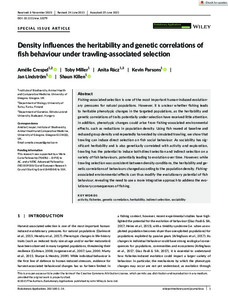Density influences the heritability and genetic correlations of fish behaviour under trawling-associated selection
Crespel Amélie; Miller Toby; Rácz Anita; Parsons Kevin; Lindström Jan; Killen Shaun
Density influences the heritability and genetic correlations of fish behaviour under trawling-associated selection
Crespel Amélie
Miller Toby
Rácz Anita
Parsons Kevin
Lindström Jan
Killen Shaun
WILEY
Julkaisun pysyvä osoite on:
https://urn.fi/URN:NBN:fi-fe2021093048480
https://urn.fi/URN:NBN:fi-fe2021093048480
Tiivistelmä
Fishing-associated selection is one of the most important human-induced evolutionary pressures for natural populations. However, it is unclear whether fishing leads to heritable phenotypic changes in the targeted populations, as the heritability and genetic correlations of traits potentially under selection have received little attention. In addition, phenotypic changes could arise from fishing-associated environmental effects, such as reductions in population density. Using fish reared at baseline and reduced group density and repeatedly harvested by simulated trawling, we show that trawling can induce direct selection on fish social behaviour. As sociability has significant heritability and is also genetically correlated with activity and exploration, trawling has the potential to induce both direct selection and indirect selection on a variety of fish behaviours, potentially leading to evolution over time. However, while trawling selection was consistent between density conditions, the heritability and genetic correlations of behaviours changed according to the population density. Fishing-associated environmental effects can thus modify the evolutionary potential of fish behaviour, revealing the need to use a more integrative approach to address the evolutionary consequences of fishing.
Kokoelmat
- Rinnakkaistallenteet [27093]
